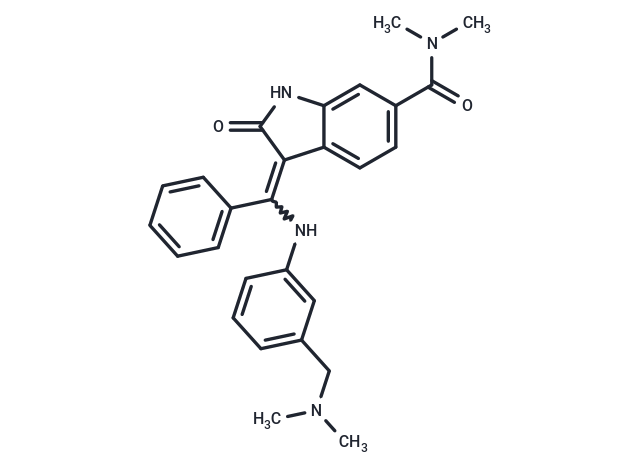Shopping Cart
- Remove All
 Your shopping cart is currently empty
Your shopping cart is currently empty

BIX02189 is a selective inhibitor of MEK5 with IC50 of 1.5 nM.

| Pack Size | Price | Availability | Quantity |
|---|---|---|---|
| 1 mg | $34 | In Stock | |
| 2 mg | $48 | In Stock | |
| 5 mg | $79 | In Stock | |
| 10 mg | $125 | In Stock | |
| 25 mg | $233 | In Stock | |
| 50 mg | $397 | In Stock | |
| 100 mg | $683 | In Stock | |
| 200 mg | $952 | In Stock | |
| 500 mg | $1,390 | In Stock | |
| 1 mL x 10 mM (in DMSO) | $88 | In Stock |
| Description | BIX02189 is a selective inhibitor of MEK5 with IC50 of 1.5 nM. |
| Targets&IC50 | MEK5:1.5 nM |
| In vivo | Pre-treatment with BIX02189 inhibits the phosphorylation of ERK5 in sorbitol-induced HeLa cells in a dose-dependent manner, without affecting the phosphorylation of ERK1/2, p38, and JNK1/2 MAPKs. BIX02189 does not exhibit cytotoxic effects in HeLa or HEK293 cells after 24 hours of treatment alone. It suppresses the expression of luciferase driven by the MEK5/ERK5/MEF2C pathway in both HeLa and HEK293 cells, with IC50 values of 0.53 μM and 0.26 μM, respectively. BIX02189 inhibits the catalytic activity of MEK5 and ERK5, with IC50 values of 1.5 nM and 59 nM respectively, and inhibits CSF1R (FMS) with an IC50 of 46 nM. However, it does not affect related kinases such as MEK1, MEK2, ERK1, p38α, JNK2, EGFR, and STK16, with IC50 values exceeding 3.7 μM. BIX02189 enhances sorbitol-induced apoptosis in NRCM cells, indicating ERK5's protective role in cardiac myocytes. At a concentration of 10 μM, BIX02189 inhibits ERK5 phosphorylation and reduces the transcriptional activity of Myocyte Enhancer Factor 2 (MEF2) in neonatal rat cardiomyocytes (NRCMs) stimulated by isoproterenol. |
| Kinase Assay | Catalytic assay: MEK5 protein isolated from the baculovirus expression system is used to measure kinase activity utilizing PKLight ATP Detection Reagent. The assay is performed using 15 nM GST-MEK5 and 0.75 μM ATP in assay buffer consisting of 25 mM Hepes, pH 7.5, 10 mM MgCl2, 50 mM KCl, 0.2% BSA, 0.01% CHAPS, 100 μM Na3VO4, 0.5 mM DTT and 1% DMSO in the presence of varying concentrations of BIX02189. The kinase reaction mixture is incubated for 90 minutes at room temperature followed by addition of 10 μL of ATP detection reagent for 15 minutes. The relative light unit (RLU) signal is measured and the RLU signals are converted to percent of control (POC) values for the determination of IC50 value. |
| Cell Research | The cells are serum starved for 20 hours prior to stimulation with sorbitol at a final concentration of 0.4 M for 20 minutes at 37 °C. BIX02189 is added 1.5 hours prior to the addition of sorbitol. The cells are harvested and lysed in 50 μL RIPA buffer containing Halt protease and phosphate inhibitors at 4 °C for 5-10 minutes. The lysates are centrifuged for 10 minutes at 14,000 rpm and 50 μL lysate is added to 50 μl 2× sample buffer and boiled for 4 minutes at 95 °C. Twenty microliters sample is run on SDS–PAGE 10% Tris-glycine gels and transferred to nitrocellulose. Western blotting is done with appropriate antibodies. (Only for Reference) |
| Molecular Weight | 440.54 |
| Formula | C27H28N4O2 |
| Cas No. | 1094614-85-3 |
| Smiles | C(NC1=CC(CN(C)C)=CC=C1)(=C2C=3C(NC2=O)=CC(C(N(C)C)=O)=CC3)C4=CC=CC=C4 |
| Relative Density. | 1.230 g/cm3 |
| Storage | Powder: -20°C for 3 years | In solvent: -80°C for 1 year | Shipping with blue ice. | |||||||||||||||||||||||||||||||||||
| Solubility Information | H2O: < 1 mg/mL (insoluble or slightly soluble) DMSO: 50 mg/mL (113.5 mM), Sonication is recommended. Ethanol: 74 mg/mL (167.98 mM), Sonication is recommended. | |||||||||||||||||||||||||||||||||||
Solution Preparation Table | ||||||||||||||||||||||||||||||||||||
DMSO/Ethanol
| ||||||||||||||||||||||||||||||||||||

Copyright © 2015-2025 TargetMol Chemicals Inc. All Rights Reserved.